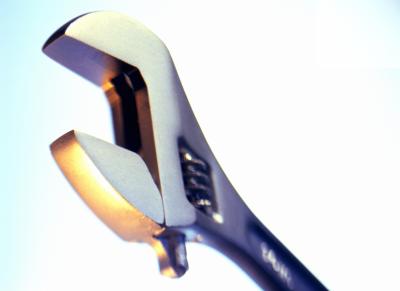
Your 1999 Pontiac Bonneville comes equipped with an in-tank electric fuel pump that provides between 48 and 55 psi (333 to 376 kPa) of pressure to handle the needs of its fast 3.0L engine. But low pressure, poor fuel flow, noises and even leaks may assault the pump after years of service. To replace the bad pump, you will need to lower the fuel tank. But before you begin, make sure you have all the necessary tools for the job.
Loosen the fuel-tank filler cap and open the hood.
Remove the fuel-injector shield, if your Bonneville model is equipped with it, using a ratchet and socket.
Disconnect the ground (black) battery cable using a wrench.
Wrap a shop towel around the fuel pressure connection fitting. This is a small valve on the fuel rail, where the fuel injectors attach, that resembles the air valve on your car tires.
Depress the valve with a screwdriver as you catch the squirt of fuel coming out of the valve with the shop towel. This will release the pressure in the fuel system.
Raise the rear of your Bonneville using a floor jack and place it on jack stands.
Chock the front wheels.
Put on your goggles, get under the vehicle and support the fuel tank with the floor jack. Place a small wood block between the jack’s saddle and the fuel tank to prevent damage to the tank.
Disconnect the rubber hangers holding the exhaust system in place on the rear of the vehicle to gain better access to the fuel tank. Use a screwdriver and a pair of needle-nose pliers.
Unfasten the two bolts from the straps holding the fuel tank in place. Use a ratchet, ratchet extension and socket.
Lower the fuel tank just enough to gain access to the hose connectors on the fuel-tank gauge sender and pump assembly.
Disconnect the hoses and unplug the electrical connector from the fuel-tank gauge sender and pump assembly. On hoses with plastic connectors, press the two tabs on the hose fittings and separate the hoses. On hoses with metal fittings use special tool J-37088-A to disconnect the lines.
Lower the tank and unlock the gauge sender and pump assembly from the fuel tank by turning the locking ring counterclockwise with tool J-24187 or similar spanner wrench.
Pull the gauge sender and pump assembly out of the tank and discard the O-ring seal on the assembly.
Disconnect the holding clamps, hoses and electrical connectors attached to the fuel pump and remove the pump from the assembly.
Place the new pump on the assembly and connect the hoses.
Install the gauge sender and pump assembly in the tank along with a new O-ring seal.
Lock the gauge sender and pump assembly to the fuel tank by turning the locking ring clockwise using tool J-24187 or similar spanner wrench.
Raise the fuel tank just enough to connect the hoses and plug the electrical connector to the fuel-tank gauge sender and pump assembly.
Raise the fuel tank in position and secure the two holding straps using the ratchet, ratchet extension and socket.
Remove the floor jack from under the vehicle.
Connect the rubber hangers to the exhaust system if you had to disconnect it. Use the screwdriver and the needle-nose pliers.
Lower your vehicle.
Tighten the fuel-filler cap.
Connect the ground (black) battery cable using the wrench.
Turn the ignition switch to the “On” position for three seconds. Turn it off and then on again and check for leaks under the fuel tank.
Turn off the ignition.